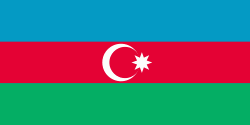Tuğ
Tugh (Tuğ) or Togh (Տող) is a village in the Khojavend District of Azerbaijan, in the disputed region of Nagorno-Karabakh. The village had a mixed Armenian-Azerbaijani population before the First Nagorno-Karabakh War, the Azerbaijani inhabitants fled the fighting in 1991, and the Armenian population fled the village during the 2020 Nagorno-Karabakh war.
The village and the neighboring fortress of Ktish (Քթիշ), are first mentioned in the 9th century, as the capital of the Principality of Dizak. In 854, Esayi Abu-Muse, the Prince of Dizak, resisted an Abbasid army under the command of Bugha al-Kabir at Ktish for more than a year.
The 13th-century monastery of Gtichavank, and ruins of some churches including the 13th-century St. Stephen's Church are located near the village. The village church is named St. John's Church and was built in 1736. A few of the Yezanyan meliks are buried in the yard of St. John's Church.
In 1737, Armenian prince (melik) Yegan built Togh's Melikian Palace here. The principality would go on to survive until the last prince, Yesayi Melik-Avanian, was killed by Ibrahim Khalil Khan in 1781, after a long-lasting resistance in the fortress of Ktish. The village was a part of the Karabakh Khanate until 1822 when it was annexed by Russia and became part of the Elisabethpol Governorate.
In 1903, a hospital was built and three years later a village school was opened which has functioned as a middle school in the present-day. A new school was built in 1978, which was renovated for the first time in 2008 by the Armenia Fund. The village also has a house of culture, a movie theater and a library.
During the Soviet period, the village was part of the Hadrut District of the Nagorno-Karabakh Autonomous Oblast.
During the First Nagorno-Karabakh War, in March 1988, Armenian armed militia detachments were formed to defend the village from Soviet and Azerbaijani attacks. The village came under Armenian control on 30 October 1991. As a result of the war, local Azerbaijani villagers were forced to flee and many settled in the Beylagan District of Azerbaijan. After the First Nagorno-Karabakh War, the village was administrated as part of the Hadrut Province of the breakaway Republic of Artsakh.
The village's Armenian population was displaced due to its capture by Azerbaijan on 9 October 2020, during the 2020 Nagorno-Karabakh war. The Artsakh Human Rights Ombudsman stated that there were reports of two civilians that had been killed, with one of them having been beheaded.
The village and the neighboring fortress of Ktish (Քթիշ), are first mentioned in the 9th century, as the capital of the Principality of Dizak. In 854, Esayi Abu-Muse, the Prince of Dizak, resisted an Abbasid army under the command of Bugha al-Kabir at Ktish for more than a year.
The 13th-century monastery of Gtichavank, and ruins of some churches including the 13th-century St. Stephen's Church are located near the village. The village church is named St. John's Church and was built in 1736. A few of the Yezanyan meliks are buried in the yard of St. John's Church.
In 1737, Armenian prince (melik) Yegan built Togh's Melikian Palace here. The principality would go on to survive until the last prince, Yesayi Melik-Avanian, was killed by Ibrahim Khalil Khan in 1781, after a long-lasting resistance in the fortress of Ktish. The village was a part of the Karabakh Khanate until 1822 when it was annexed by Russia and became part of the Elisabethpol Governorate.
In 1903, a hospital was built and three years later a village school was opened which has functioned as a middle school in the present-day. A new school was built in 1978, which was renovated for the first time in 2008 by the Armenia Fund. The village also has a house of culture, a movie theater and a library.
During the Soviet period, the village was part of the Hadrut District of the Nagorno-Karabakh Autonomous Oblast.
During the First Nagorno-Karabakh War, in March 1988, Armenian armed militia detachments were formed to defend the village from Soviet and Azerbaijani attacks. The village came under Armenian control on 30 October 1991. As a result of the war, local Azerbaijani villagers were forced to flee and many settled in the Beylagan District of Azerbaijan. After the First Nagorno-Karabakh War, the village was administrated as part of the Hadrut Province of the breakaway Republic of Artsakh.
The village's Armenian population was displaced due to its capture by Azerbaijan on 9 October 2020, during the 2020 Nagorno-Karabakh war. The Artsakh Human Rights Ombudsman stated that there were reports of two civilians that had been killed, with one of them having been beheaded.
Map - Tuğ
Map
Country - Azerbaijan
 |
 |
| Flag of Azerbaijan | |
The Azerbaijan Democratic Republic proclaimed its independence from the Transcaucasian Democratic Federative Republic in 1918 and became the first secular democratic Muslim-majority state. In 1920, the country was incorporated into the Soviet Union as the Azerbaijan SSR. The modern Republic of Azerbaijan proclaimed its independence on 30 August 1991, shortly before the dissolution of the Soviet Union in the same year. In September 1991, the ethnic Armenian majority of the Nagorno-Karabakh region formed the self-proclaimed Republic of Artsakh. The region and seven surrounding districts are internationally recognized as part of Azerbaijan pending a solution to the status of the Nagorno-Karabakh through negotiations facilitated by the OSCE, although became de facto independent with the end of the First Nagorno-Karabakh War in 1994. Following the Second Nagorno-Karabakh War in 2020, the seven districts and parts of Nagorno-Karabakh were returned to Azerbaijani control.
Currency / Language
| ISO | Currency | Symbol | Significant figures |
|---|---|---|---|
| AZN | Azerbaijani manat | ₼ | 2 |
| ISO | Language |
|---|---|
| HY | Armenian language |
| AZ | Azerbaijani language |
| RU | Russian language |















